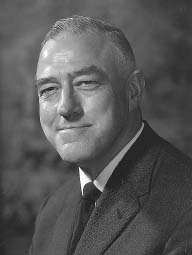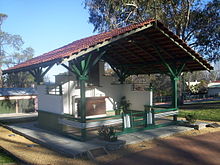Michael Woodruff
Sir Michael Woodruff FRCS | |
|---|---|
 | |
| Born | 3 April 1911 Mill Hill, London, England |
| Died | 10 March 2001 (aged 89) |
| Alma mater | University of Melbourne |
| Awards |
|
| Scientific career | |
| Fields | Organ transplantation |
| Institutions | Universities of Sheffield, Aberdeen, Otago, Edinburgh |
Sir Michael Francis Addison Woodruff,
At the conclusion of the war, Woodruff returned to England and began a long career as an academic surgeon, mixing clinical work and research. Woodruff principally studied transplant rejection and immunosuppression. His work in these areas of transplantation biology led Woodruff to perform the first kidney transplant in the United Kingdom, on 30 October 1960. For this and his other scientific contributions, Woodruff was elected a Fellow of the Royal Society in 1968 and made a Knight Bachelor in 1969. Although retiring from surgical work in 1976, he remained an active figure in the scientific community, researching cancer and serving on the boards of various medical and scientific organisations.
Early life
Michael Woodruff was born on 3 April 1911 in Mill Hill,[2] London, England, the son of Harold Addison Woodruff and his wife, Margaret Ada Cooper.[3] In 1913, his father, Harold Woodruff, a professor of veterinary medicine at the Royal Veterinary College in London, moved the family to Australia so he could take up the post of Professor of Veterinary Pathology and Director of the Veterinary Institute at the University of Melbourne. The elder Woodruff later became the Professor of Bacteriology.[3] The family's new life in Australia was interrupted by World War I, which prompted Harold to enlist in the armed services. He became an officer in the Australian Army Veterinary Corps and was sent to Egypt.[4]
The remainder of the Woodruffs returned to London, and the two boys lived with their mother and paternal grandmother in the latter's residence in Finchley. Michael and his brother went back to Australia in 1917 after their mother, Margaret, died of a staphylococcal septicaemia. The two then spent a short time under the care of an aunt before being rejoined by their father in 1917.[3][5]
In 1919, Harold remarried and his new wife raised the children from his first marriage. The two boys did their early schooling at
He won a government scholarship to the
After graduating in 1933, he entered the medical program at the University of Melbourne. His mentors included anatomy professor
World War II
At the outbreak of

After being captured, Woodruff was imprisoned in the
While stationed at the River Valley Road prisoner of war hospital in Singapore in 1945, with the supplies of chemical anæsthetics severely restricted by the Japanese, Woodruff and a medical/dental colleague from the Royal Netherlands Forces successfully used hypnotism as the sole means of anæsthesia for a wide range of dental and surgical procedures.[8]
At the conclusion of World War II, Woodruff returned to Melbourne to continue his surgical training. During his studies, he served as the surgical associate to Albert Coates. This position was unpaid, so Woodruff accepted an appointment as a part-time pathology lecturer to support himself.[9] In January 1946, Woodruff participated in an Australian Student Christian Movement meeting, where he met Hazel Ashby, a science graduate from Adelaide. She made a great impression on Woodruff, and he married her half a year later. The couple were research partners for the rest of their lives.[3][9]
Early career
Soon after his marriage, Woodruff travelled to England to take the second half of the
Sheffield
After passing his exam, Woodruff entered his position at Sheffield, where he trained in emergency and elective surgery.
Aberdeen
In 1948, shortly after applying for the position in Melbourne, Woodruff moved from Sheffield to the
While in Aberdeen, Woodruff also visited the United States on a World Health Organization (WHO) Travelling Fellowship. During the visit, he met many of the leading American surgeons, an experience that increased his own desire to continue his work and research. After returning from the US, Woodruff experimented with the effects of cortisone and the impact of blood antigen on rejection. As part of his blood antigen studies, Woodruff found two volunteers with identical blood antigens and arranged for them to exchange skin grafts. When the grafts were rejected, Woodruff determined that rejection must be controlled by additional factors.[3][12] In 1951 Woodruff was awarded a Hunterian Professorship of the Royal College of Surgeons of England for his lecture The transplantation of homologous tissue and its surgical application.[12]
Dunedin

In 1953, Woodruff moved to
Edinburgh
In 1957, Woodruff was appointed to the Chair of Surgical Science at the
The research group's principal investigations concerned

Woodruff performed the first ever kidney transplant in the UK, at the Royal Infirmary of Edinburgh.[14] He had been waiting for the right patient for some time, hoping to find a patient with an identical twin to act as the donor, as this would significantly reduce the risk of rejection. The patient that Woodruff eventually found was a 49-year-old man suffering from severely impaired kidney function who received one of his twin brother's kidneys on 30 October 1960. The donor kidney was harvested by James Ross and transplanted by Woodruff. Both twins lived an additional six years before dying of an unrelated disease.[14] Woodruff thought that he had to be vigilant with his first kidney transplant, as he regarded the British medical community's attitude to be conservative towards transplantation.[13] From then until his retirement in 1976, he performed 127 kidney transplants.[13] Also in 1960, Woodruff published The Transplantation of Tissues and Organs, a comprehensive survey of transplant biology and one of seven books he wrote.[3] He was awarded the 1969 Lister Medal for his contributions to surgical science.[15] The corresponding Lister Oration, given at the Royal College of Surgeons of England, was delivered on 8 April 1970, and was titled 'Biological aspects of individuality'.[16]
The success of Woodruff's clinical transplant program was recognised and enhanced by funding from the Nuffield Foundation to construct and open the Nuffield Transplant Surgery Unit at the Western General Hospital in Edinburgh.[17] In 1970 an outbreak of hepatitis B struck the transplant unit, resulting in the death of several patients and four of Woodruff's employees due to fulminant hepatic failure. Woodruff was deeply shaken by the loss and the unit was closed for a period while an investigation was carried out to develop a contingency plan to avoid such a disaster in future. The unit then resumed operations.[17]
Woodruff retired from the University of Edinburgh in 1976,
Legacy
Woodruff's contributions to surgery were important and long-lasting. In addition to performing the first kidney transplant in the UK, he devised a method of implanting a transplanted
These important contributions to medicine and biology were first seriously honoured in 1968 when Woodruff was elected to be a
Despite his profound influence on transplantation and what Peter Morris called "a commanding presence in any gathering",[21] Woodruff was not known for his ability as a lecturer as he had a rather uncertain style of presentation and a tendency to mumble.[21] Nevertheless, Morris said that Woodruff has "a great turn of phrase and a rather wicked sense of humour".[21] Morris concluded that "What is surprising is that he was not successful in producing many surgeons in his own mould, despite the intellectual talent that was entering surgery and especially transplantation in the 1960s. However, his influence in transplantation at all levels was enormous."[21]
Publications
Woodruff's impact is also apparent in his large volume of publications. In addition to authoring over two hundred scholarly papers,[22] Woodruff wrote eight books during his career, covering numerous aspects of medicine and surgery.
- Deficiency Diseases in Japanese Prison Camps. M.R.C Special Report No. 274. H.M. Stationery Office, London 1951.
- Surgery for Dental Students. Blackwell, Oxford. (Fourth Ed., 1984 with H.E. Berry) 1954.
- The Transplantation of Tissues and Organs. Charles C. Thomas. Springfield, Illinois 1960.
- The One and the Many: Edwin Stevens Lectures for the Laity. Royal Society of Medicine, London 1970.
- On Science and Surgery. Edinburgh University Press, Edinburgh 1976.
- The Interaction of Cancer and Host: Its Therapeutic Significance. Grune Stratton, New York 1980.
- Cellular Variation and Adaptation in Cancer: Biological Basis and Therapeutic Consequences. Oxford University Press 1990.
- Nothing Venture Nothing Win. Scottish Academic Press 1996. (autobiography)
Personal life
In 1946 Woodruff married Hazel Gwenyth Ashby.[23]
The Woodruffs had two sons, followed by a daughter. Their first son completed a
Woodruff was a lover of classical music, and after taking up the organ at university and learning from A. E. Floyd, the organist of St Paul's Cathedral,[6] he became the college organist at Queen’s College in Melbourne; he later learned to play the piano.[25] In his spare time, Woodruff continued to pursue his love of pure mathematics, especially number theory. He periodically attempted to prove Fermat's Last Theorem, but failed.[25]
References
- ^ a b c d e f Morris, Peter (31 March 2001). "Professor Sir Michael Woodruff". The Independent. London. Archived from the original on 8 September 2010. Retrieved 10 April 2010.
- ^ "FreeBMD Entry Info". FreeBMD. Retrieved 9 March 2020.
- ^ S2CID 73171252.
- ^ Morris, p. 457.
- ^ ISBN 0-7073-0737-6.
- ^ a b c d e f Morris, p. 458.
- ^ a b c d Morris, p. 459.
- ^ Sampimon, R.L.H. & Woodruff, M.F.A., "Some Observations Concerning the use of Hypnosis as a Substitute for Anæsthesia", The Medical Journal of Australia, (23 March 1946), pp. 393–395.
- ^ a b Morris, p. 460.
- ^ a b c d e Morris, p. 461.
- ^ Morris, pp. 461–462.
- ^ a b c d e f Morris, p. 462.
- ^ a b c d e f Morris, p. 463.
- ^ a b "History of Kidney Transplantation in Edinburgh". Archived from the original on 6 February 2009. Retrieved 30 November 2008.
- PMC 2387642.
- PMID 4393495.
- ^ a b Morris, p. 464.
- PMID 9158539.
- ^ Minute Books of the Harveian Society. Library of the Royal College of Physicians of Edinburgh.
- ^ Morris, p. 467.
- ^ a b c d e f Morris, p. 469.
- S2CID 73171252.
- ISBN 978-0-902198-84-5. Archived from the original(PDF) on 4 March 2016. Retrieved 11 September 2019.
- ISBN 0-7073-0737-6.
- ^ a b Morris, p. 468.
Further reading
- Sir Michael Woodruff, The Guardian
- Leigh W (February 2011). "Sir Michael Francis Addison Woodruff (1911-2001) FRS DSc MD MS FRCS". J Med Biogr. 19 (1): 21–5. S2CID 207200478.
- MacDonald H (October 2015). Guarding the Public Interest: England's Coroners and Organ Transplants, 1960–1975, Journal of British Studies
